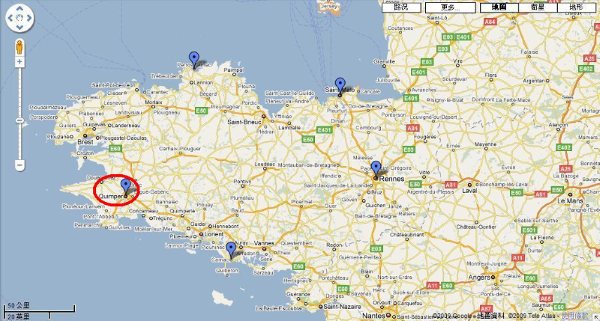Saint-Malo
Saint-Malo is a port city located on north Bretagne. It was established in 6th century by Saint Aaron and Saint Brendan who settled in Saint-Malo. Between 1490 and 1493, Saint Malo declared an independent republic, claiming that those lived in Saint-Malo were “not French, not Breton, but Malouins.” It was also during this time that Saint-Malo became the dwellings of pirates and privateers, who prayed on ships in English Channel. Due to its location, Saint-Malo also has many seafood restaurants, and is especially famous for the oysters from nearby village. (Too bad I don’t eat oysters…  )
)
Outside the city walls is a more modern area.
Near the city walls.
The castle and great keep of Saint-Malo. Part of it has been converted to a museum.
There are several forts in Saint-Malo: Le Fort National, Le Fort de l’ile Harbour, Le Fort du Grand-Be, Le Fort du Petit-Be, Le Fort de la Conchee. Le Fort National and Le fort du Petit-Be could be walked to during low tide. Le Fort du Grand-Be was severely damaged during World War II and only the foundation remained now. Le Fort de la Conchee was also damaged during the war but is being restored. Le Fort de l’ile Harbour can’t be visited.
This is Le Fort National was commissioned by Louis XIV and built in 1689 to defend Saint-Malo.
Closer view of Le Fort National
The beach farer away from Le Fort National.
Clear blue ocean…
Entrance to the walled city near Esplanade Félicité Robert de Lamennais. Old city center is encircled and protected by these 6-meter thick walls.
Place Chateaubriand.
Offices? Residential houses?
Part of the ramparts.
A seafood restaurant’s takeout window around the corner of Place Chateaubriand. You can see shrimps, lobsters, crabs, shells, and oysters getting arranged and packed up here.
Street views in old city center.
This store sells native Breton products. The white cups in front of the store are cider mugs. Cider is a traditional beverage in Bretagne that goes with “crêpe” and “gallete.”
More street views…
A cathedral right on the street, but I’m not sure if it’s still in use since the ground level is used as a candy store.
The store that sells all kinds of canned fish.
You can walk on top of the ramparts and enjoy the magnificent view of the city and ocean. This is a residential building just besides the rampart.
On of the residential buildings with very green courtyard.
Marvelous coastal views from the fortification.
On top of a platform of the rampart.
I think the farer isle is Le Fort du Petit-Be.
Cathedral of St-Vincent.
A black cat enjoyed the sunshine.
This is the traditional food in Bretagne–gallete and cidre. I read somewhere that in order to save food but also not feeling hungry, Breton invented gallete which is a very thin pancake made of buckwheat topped with vegetable and/or some meat. I think most people are more familiar with crêpe. Crêpe is also a Breton food but different from gallete, crêpe is made of wheat flour and topped with fruit and sweet things like chocolate, sugar, or whip cream. Crêpe is usually served as dessert. Gallete is more like a main course and Breton people eat it with a cup of cidre–apple cider brewed in Bretagne.
During night time~
This is the hotel where I stayed at Saint-Malo, which is the best hotel in my trip this time, very spacious and elegant. Even better–it offered a great deal while I stayed. I stayed in the top floor and could see the ocean from the balcony. 
The lounge area in the hotel with very oceanic atmosphere.
Splendid view from the dining area. The decoration matched the oceanic scenery very well. 
Jacuzzi area in the courtyard of the hotel.
































































































